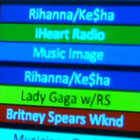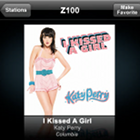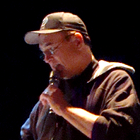Dave Foxx explains Z100’s programming tactics for station imaging. The production director also talks about how to keep the audience tuned in during commercial breaks.
Part 1 of this article showed the importance of keeping overview and think ahead of the production schedule. We’ve also covered how to write promos that ‘sell’ by identifying your point, and how to stimulate creativity by letting your brain build bridges between several different events. This part is about programming station imaging and commercials strategically.
Topics
- Where the 3 promo positions are within the format clock of Z100
- Why it’s important to pre-sell something before (or play a station promo into) a stop set
- Which specific commercial scheduling tactic keeps more people listening during breaks
- What different radio imaging elements are being used on New York’s Hit Music Station
 Promos before stopset
Promos before stopset
After Dave Foxx showed how they produce spots for station promotions at Z100, I wanted to know how they schedule them. He was kind enough to share it. “We play promos before going into commercials and we usually have two stop sets an hour. In some hours we’ll do three. We have to load up on some hours as every afternoon at 4:30 we play 100 minutes commercial free music”, Foxx explains.
One primary promo
New York’s Hit Music Station plays its primary promo (like Rihanna/Ke$ha; the top one in the picture above) right before the first stop set. This element is being played every hour and is therefore the highest rotating promo of all. “It has to do with studies. They show that a promo has to play a certain number of times before the majority of the audience actually hears it.”
 Two secondary promos
Two secondary promos
The two secondary promos will play right before the second stop set and rotate equally: one every hour, one every other hour. One is usually an image benchmark promo. It highlights stations events that people specifically tune in for, like Elvis Duran & The Morning Show Phone Taps (every morning at 7:20 and 9:20). In the example we see that the first secondary promo is for the Clear Channel iHeart Radio app.
Sub promos
Also playing in this secondary position is a sub promo for smaller events, like an up close & personal artist showcase for listeners of z100. These performances take place in the intimate P.C. Richard & Son Theater, located on the ground floor of Clear Channel New York’s headquarters. The example shows a generic music imaging promo (music montage with core songs to explain the format). Music imagers could also be played right before the tertiary stopset, if there is one.
 Sound determines order
Sound determines order
Z100 plays commercials in a carefully scheduled running order. Why? Indeed. Keep the audience listening throughout the break, that’s the reason! Based on what Dave Foxx says, it seems like a simple but effective rule. “The higher the production value, the earlier in the stop set it’s going to come. Sometimes clients get the first position by contract – but when that’s not the case, the spot with the highest production value goes first.”
Hold listener’s attention
The first spot to kick off a stopset could be a typical Coke-commercial. These’re usually well produced commercials with full vocals, rich harmonies and multiple layers. Foxx: “That’s what keeps people’s interest. Whether they’re interested in Coca-Cola or not; the production value holds the attention. The last one is always the most boring commercial of all.”
 Psychology behind programming
Psychology behind programming
The tactics of commercial scheduling has to do with psychology and human nature. “The audience knows we’re only break for an x amount of time; they have a feel of how long it’s going to be. The further you get them to stay with you into the stop set, the less likely they will go away. They might think: well, I’ve got a shot for a million dollars here; I better stay with it. Or: my favorite song might come up next.”
Z100 station imaging elements
I asked Dave what kind of imaging elements they use on the station, and where these are positioned. It was quite eductional, because I have never heard of Tweeners and Squeezers before :-). Here’s the list:
- Sweepers go in between any two other elements, are contiguous (adjacent to another object) and do not involve any talking by the deejay
- Stagers set the stage for something that happens right now (for example: “Now, it’s time for the nine biggest songs in New York” to announce the beginning of the Interactive 9 at 9)
- Top of hours kick off a new hour and are sometimes used as contest stage device – these consist of a jingle where the deejay talks over its ramp and delivers a liner, before the sung vocals (“Z100, New York”) come in
- Bumpers go into a stop set and often consist of a promo that leads into the actual commercials, and sometimes get a live presented liner or teaser by the deejay upfront (for example: “Your chance to win one million dollars coming up soon”)
- Tweeners go in between two commercials and are used for a legal ID (“WHTZ New York, New Jersey and Connecticut”) or as ad lib setups (short announcements that are in fact stagers for short 5-second ads).
- Squeezers fill the gaps in a split commercial break (when one or more local editions have less commercials scheduled than others), to synchronize all breaks – so all stopset editions will return to the music simultaneously
 Coming soon: Dave’s bible
Coming soon: Dave’s bible
“It’s funny, just about every radio station call things differently”, Foxx says. “Like when someone is asking: hey – can you do some liners? I’d say: uuh, I don’t do liners, you write them and give them to the discjockeys – they read the liners… I’m writing a book on production, and in that book I’m going to insist that everyone is going to use the same terminology, haha.” (Right after the book has been released, I’ll write a review for you here.)
Read also: Dave Foxx Z100: Big Picture = Better Production





Add Your Comment